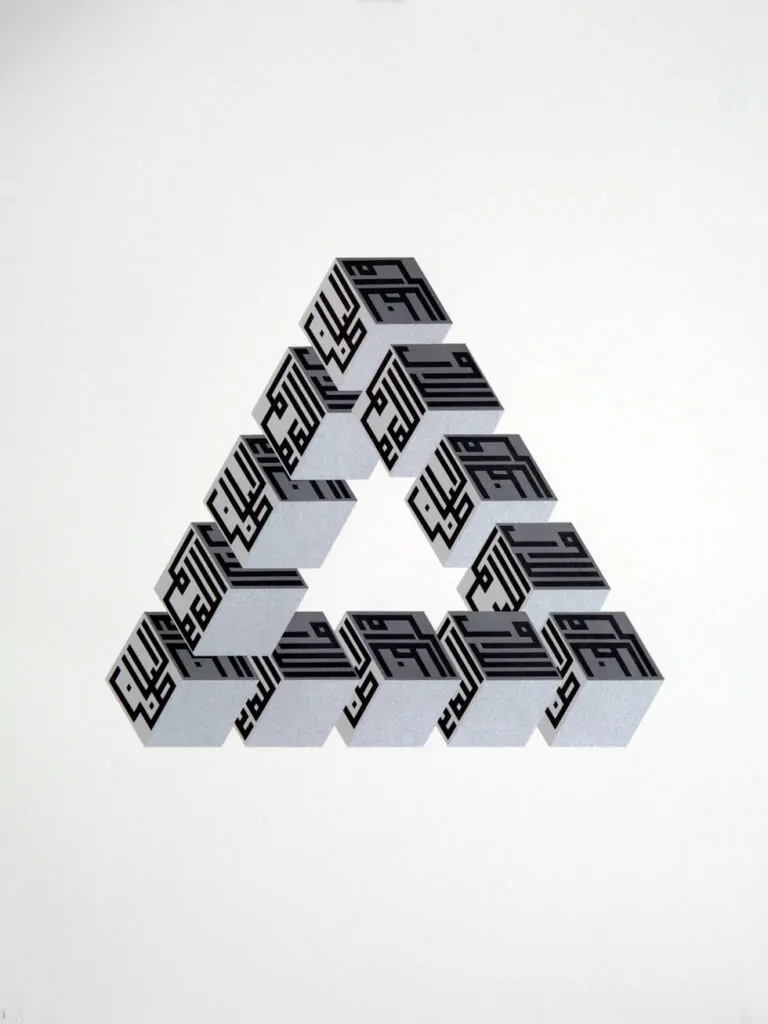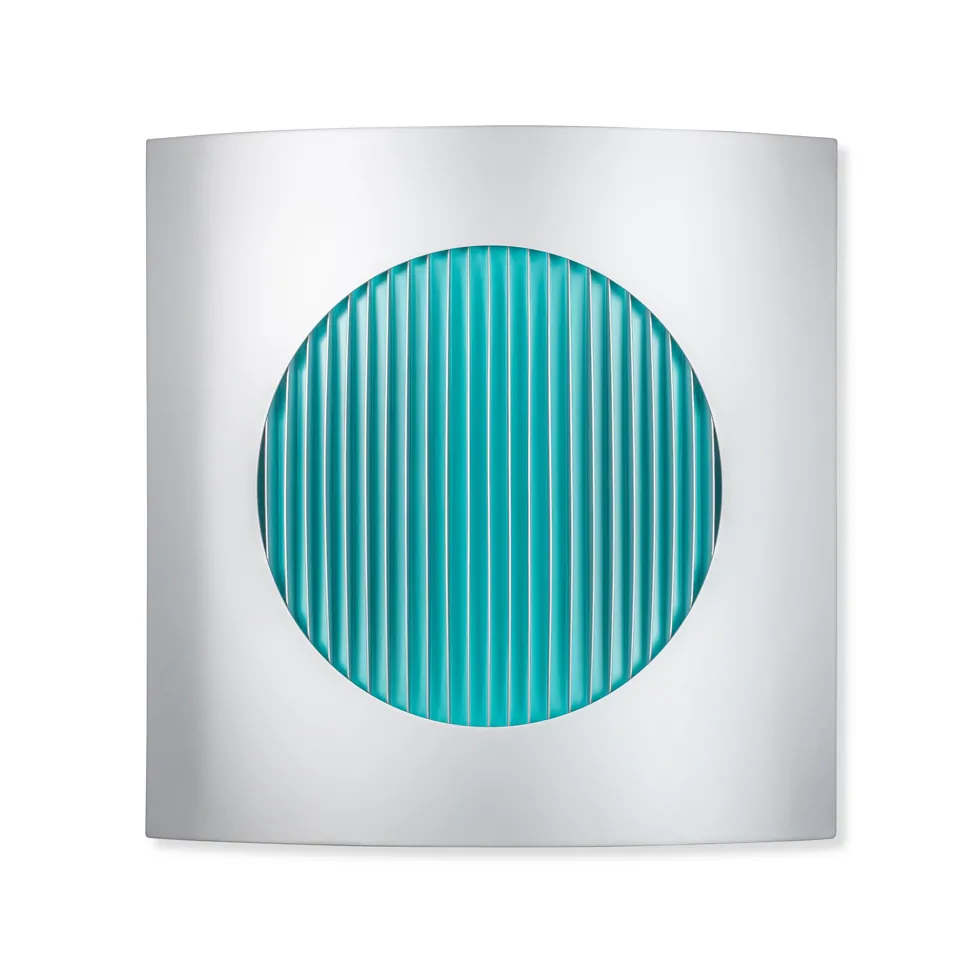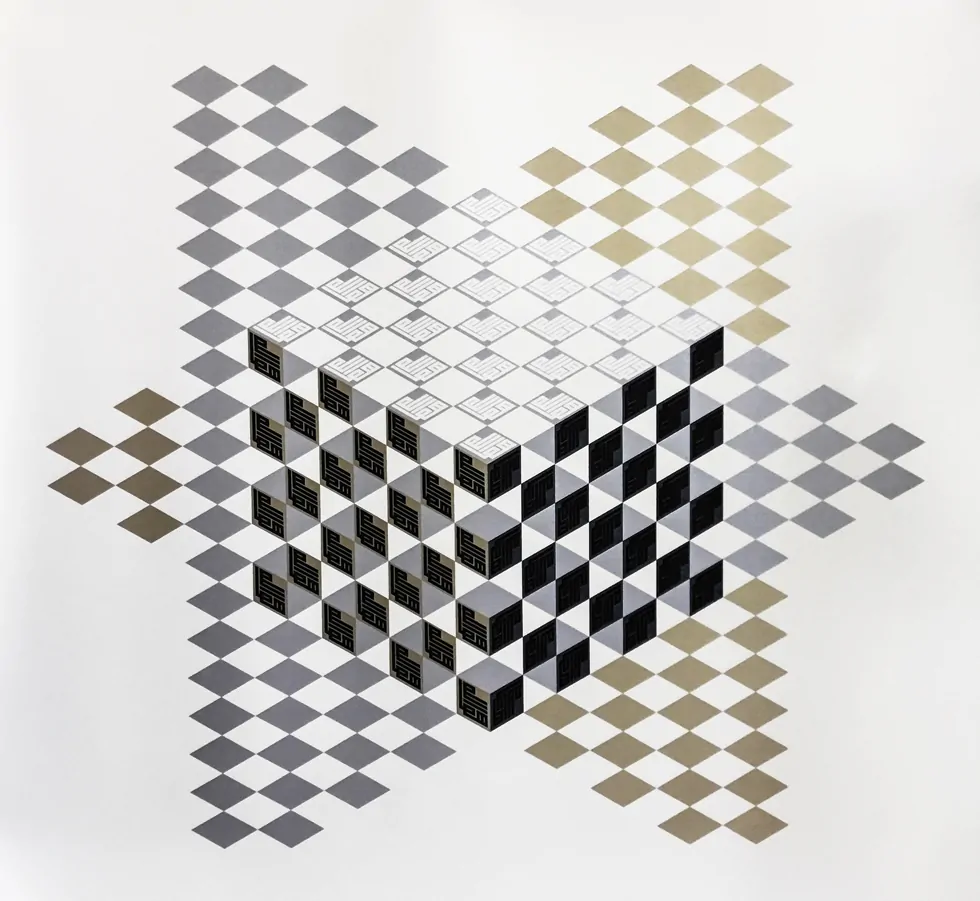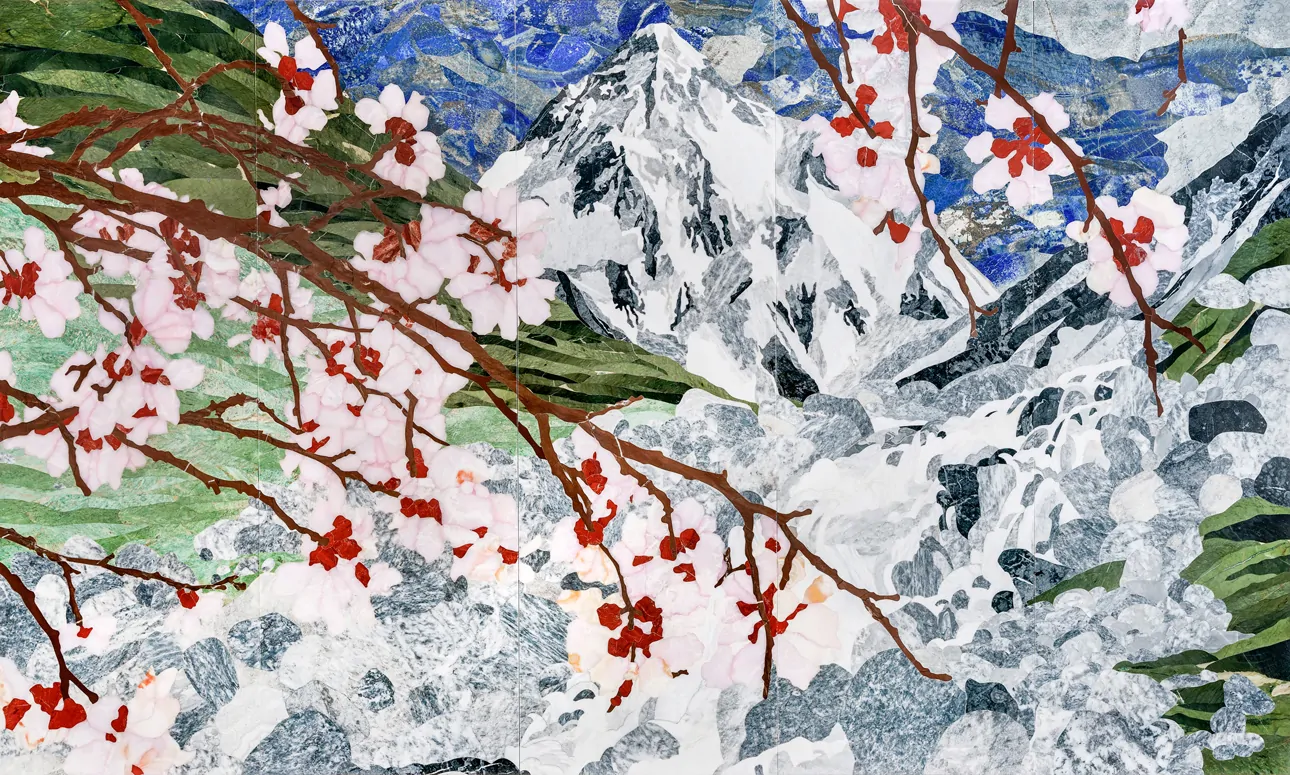Fragments of Folklore presented by THAA, MIR’A, and TRIYAD
30th April, 2025 – 12th May, 2025
JAX District
Riyadh, Saudi Arabia
In Riyadh’s JAX District, where warehouses once stood dormant under the desert sun, a quiet but insistent energy has taken hold. A new exhibition is drawing artists, curators and curious onlookers into conversation. Fragments of Folklore, a tightly curated show featuring four artists rooted in Islamic visual traditions, is not simply an exhibition—it reflects a nation mid-pivot, reckoning with its heritage while imagining new cultural horizons.
Rashid Al Khalifa, Lulwah Al Homoud, Raeda Ashour and Hamra Abbas engage with folklore not as something frozen in time but as material to be questioned, recast and, at times, contradicted. Their work draws from inherited forms—geometry, calligraphy, textile, architecture—yet articulates them through distinctly contemporary lenses. In their hands, tradition becomes a field of experimentation.

JAX is no accidental choice of venue. Now a nerve centre of Saudi Arabia’s contemporary art movement, this former industrial zone has become emblematic of the Kingdom’s broader shift: a cultural terrain long defined by restraint, now cautiously—yet visibly—expanding under the rubric of Vision 2030, the Kingdom’s sweeping programme of reform. That three of the four exhibiting artists are women—including the Saudis Al Homoud and Ashour—signals not only curatorial intent but a wider recalibration of visibility and voice in public life.
What unifies the works on view is not aesthetic similarity but a shared impulse to dissect memory. Abbas’s vivid compositions reference sacred ornamentation but are shot through with diasporic complexity and feminist unease. Al Khalifa’s meditative structures channel both architectural lineage and political stillness. Al Homoud’s calligraphic experiments dissolve language into abstraction. Ashour’s palette is personal, intimate—threading familial references with spiritual weight.
The show’s title is more than poetic. These are not coherent myths, but fragments—coded remnants of cultural memory, marked by time, geography and reinterpretation. The works do not treat heritage as sacrosanct. They touch it, unsettle it and reassemble it into something that resists nostalgia.

That curatorial stance departs from a well-worn model in the Gulf: one that privileges the import of blockbuster names and Western cultural capital. Fragments of Folklore, by contrast, is the result of a tripartite collaboration between Saudi Arabia’s THAA, MIR’A Art (Paris/Middle East) and Belgium’s TRIYAD—three institutions bridging regional specificity with international discourse. The result is not spectacle, but dialogue.
This exhibition is more than a presentation of works—it is a movement that brings visibility to artists shaping the artistic landscape of Saudi Arabia and beyond. By bringing these voices to the forefront, Fragments of Folklore actively contributes to shaping art history, ensuring that heritage is both preserved and dynamically reimagined for future generations.” — Lisa De Boeck, Curator & Founder of TRIYAD
The timing is deliberate. The exhibition coincides with the Kingdom’s Year of Handicrafts 2025, a government initiative that aims to reposition traditional craft as a vital, contemporary practice. Meanwhile, Saudi Arabia’s cultural calendar is busier than ever. In AlUla, Desert X continues its dialogue between land art and ancient geology. In Jeddah, the Islamic Arts Biennale traces a lineage from sacred art to postmodern interpretation.
But it is the Kingdom’s institutional infrastructure that most clearly signals its ambitions. A Centre Pompidou satellite is taking shape in AlUla. A Louvre outpost is slated for Riyadh. Sotheby’s will stage its first Saudi auction this year. Once peripheral to the international art market, the Kingdom is now building a presence that extends beyond mere visibility—towards legacy.
In this context, Fragments of Folklore reads not as a symbolic gesture, but as a thesis. It suggests that the Kingdom’s cultural shift is not merely strategic or state-driven, but part of a deeper, generational reckoning with identity. These artists are not preserving the past—they are engaging with it, distilling it, reshaping it for an audience unafraid of complexity.
Among the raw concrete façades of JAX, softened now by studios, galleries and conceptual design spaces, a dialogue is unfolding—about authorship, ancestry and the porous boundaries between memory and myth. At its heart are artists who understand that, in a region undergoing rapid reinvention, the future of art may not be written in grand declarations—but in fragments, quietly, insistently and with intent.
Artists in Conversation with Tradition
Hamra Abbas (Pakistan)
In the hands of Hamra Abbas, tradition becomes a site of friction as much as continuity. Drawing on the language of South Asian miniature painting and the tactile precision of marble inlay, Abbas mines the visual vocabulary of Islamic art—not to replicate it, but to reconsider it. Her materials carry historical weight, but her treatment resists nostalgia. What emerges are objects that oscillate between the sacred and the subversive, balancing devotional aesthetics with pointed cultural reflection. Her work has appeared in institutions including the Venice Biennale and Sharjah Biennial, though its sharpness feels grounded, above all, in the studio.
Lulwah Al Homoud (Saudi Arabia)
Lulwah Al Homoud approaches the Arabic script less as language than as form—deconstructing calligraphic traditions until only structure, rhythm and geometry remain. The results are intricate yet restrained, distilling centuries of visual philosophy into compositions that feel both analytical and meditative. Her practice draws from Islamic cosmology and mathematical logic, yet remains deeply personal in its tone. Beyond her own work, Al Homoud has helped shape the Saudi art scene through LAHAF, the foundation she founded to support emerging artists. Her pieces are held in the collections of the British Museum and LACMA—though they often seem most at home in quiet, focused spaces.
Rashid Al Khalifa (Bahrain)
Rashid Al Khalifa’s work resists easy categorisation. Somewhere between sculpture and relief, his installations respond to space as much as to surface. Influenced by Islamic ornamentation but pared down to essential geometry, his pieces engage the eye slowly—patterns unfolding through shadow, repetition and light. There’s no didactic message here, only atmosphere. His materials—aluminium, steel, industrial paints—pull classical forms into the present without abandoning their lineage.
Raeda Ashour (Saudi Arabia)
Raeda Ashour’s compositions feel built rather than painted—layered with fragments of architecture, calligraphy and memory. Her palette is warm, her structures formal, but the work carries something lived-in. Drawing from the ornamental vocabulary of Islamic art, she reconfigures it into quiet, dynamic spaces that speak to inheritance and reinvention. Ashour has been largely absent from recent public exhibitions. Her return here reintroduces a voice that has long operated outside of fashion—grounded, measured, and attentive to detail.

Beyond the Exhibition: Expanding the Frame of Cultural Access
Fragments of Folklore is not merely a collection of artworks—it gestures toward something broader: a structural investment in how art is shared, supported and sustained in the region. Around the exhibition, a number of initiatives have taken root, reflecting a larger ambition to reshape the infrastructure of artistic visibility in and beyond Saudi Arabia.
Mentorship and Support
At its foundation is a commitment to emerging talent. Through a network of curators, institutions and senior artists, Fragments of Folklore creates a framework for mentorship, offering early-career artists not just exposure, but guidance and institutional engagement within Saudi Arabia and abroad.
Cross-Border Collaborations
The exhibition extends far beyond Riyadh. Through partnerships with organisations in Paris, Brussels and other cultural centres, it opens a channel for sustained exchange—connecting artists from the Gulf and South Asia with international audiences, not as token representatives, but as co-authors of global artistic discourse.
Living Heritage
Rather than treat heritage as something to be safeguarded behind glass, the exhibition insists on its ongoing relevance. The artworks—and the conversations around them—position cultural memory as dynamic, urging reinterpretation rather than preservation alone.
Decentralising the Narrative
With artists from Saudi Arabia, Bahrain and Pakistan, the exhibition resists the gravity of a Eurocentric canon. In doing so, it aligns with a broader art-world recalibration—one that centres regional voices not as peripheral commentary, but as the makers of the narrative itself.
Art for Ownership
A curated art store accompanies the exhibition, offering prints and smaller-scale works at accessible price points. It’s a quiet but pointed gesture—inviting a wider public not just to view, but to collect. In this way, Fragments of Folklore expands the idea of art as exclusive object to something more open, more democratic, and more lived.
Fragments of Folklore presented by THAA, MIR’A, and TRIYAD opens on the 30th of April, 2025 until the 12th of May, 2025 in the JAX District
©2025 THAA, MIR’A, and TRIYAD




